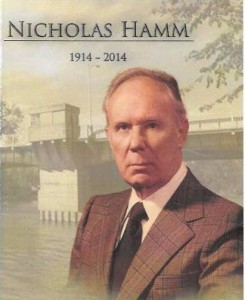Nicholas Hamm: born 1914 in New York, Russia
My parents were Peter Abram Hamm, born in Alexandrovsk, on the Dnieper River and Margaretha Unger, daughter of Peter H. Unger, born in Einlage, Chortitza Colony, Russia.
My first memory is of WWI, 1914-1918, when the German occupational forces were billeted in Mennonite homes in our village. This provided them with an opportunity to rest up. The Mennonite people in Russia were pro-German and this stirred up resentment on the part of the Russian people. Later the Mennonites were persecuted for this when the Macknov bandits performed atrocities against our people for our pro-German stance. Our Mennonite people put themselves above the nationals. But we had been invited to settle in Russia to show the Russian people how to farm. Katherine the Great and Peter the Great recognized that they had something to learn from the West and looked to the European nations to build up their people and their nation.
My mother was educated in Russian schools and boarded with Russian families in Bachmut, located about 40 Kl from our home. By the time Mother was a teenager, she spoke Russian perfectly, something the regular Russian citizens did not. Mother’s older sister, Lena Friesen, had attended the same school there earlier.
My teachers over the years were Miss Hollemberg who taught the alphabet, reading and writing and later lived in Reesor, Ontario: Peter Sawatzky (late John’s father) taught mathematics; Johann Thiessen and Alexander Nickel, who was principal of the Centralschule.
My aunts Janzen and Liese Dyck never left Russia; they were taken to the Gulag in Siberia. My aunt Tina (Gerhard) Funk came to Canada. Her father Heinrich Funk was the village Elder of New York. My youngest aunt, Lily Hamm Goosen and her husband decided to return to their Russian home in New York. They found the buildings there intact, there was a consumer market on the street corner and the other corner had a bookstore. This had been my Uncle Heinrich Hamm’s bookstore which also had a book bindery. During the famine in the 1920s, Uncle Heinrich constructed children’s games such as checkers, etc. Lena painted post cards which sold well.
Lumber was transported on barges. Johann’s sister Tante (Aunt) Kornelius Hamm, who was father’s aunt worked there. At this time, the Mennonite people were moving north to Siberia where they founded new colonies.
I came to Canada with my family in 1927 at 12 years of age. My first language was High German, then Low German, followed by English. I understood the Russian and Ukrainian languages.

